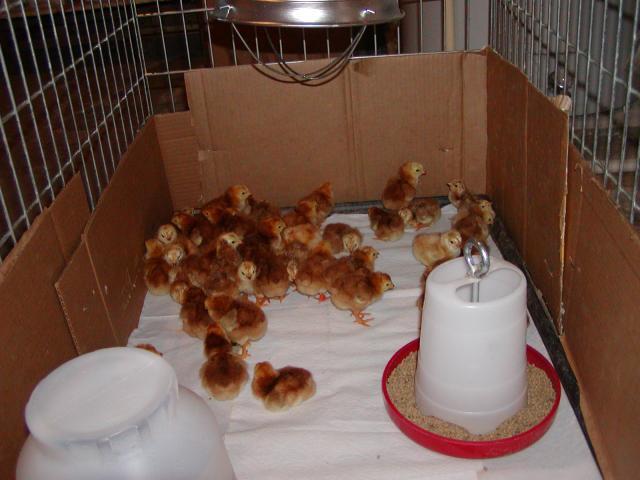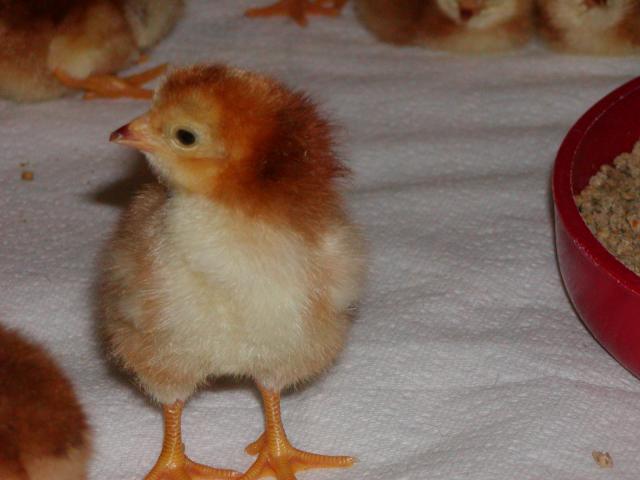Yes, I don't show them at all. I was selling hatching eggs from some other stock that I have, but I don't plan on selling any more.
Navigation
Install the app
How to install the app on iOS
Follow along with the video below to see how to install our site as a web app on your home screen.
Note: This feature may not be available in some browsers.
More options
You are using an out of date browser. It may not display this or other websites correctly.
You should upgrade or use an alternative browser.
You should upgrade or use an alternative browser.
Buckeye Breed Thread
- Thread starter Pathfinders
- Start date
- Status
- Not open for further replies.
Quote:
Quote:
We liked the looks of 41 a lot too, but have decided to keep the biggest five awhile longer and wait to do the final choosing. We really appreciate the input on which look better even though they're a little young.

Quote:
We liked the looks of 41 a lot too, but have decided to keep the biggest five awhile longer and wait to do the final choosing. We really appreciate the input on which look better even though they're a little young.

- Jul 21, 2010
- 3,788
- 15
- 181
good choice! IMO #45 & 38 were best wait and see how they fill out.
Quote:
I think your advice is good, and that's what we're doing - culling any with defects, and the small ones. We'll let the bigger ones get a bit older and gradually decide. It seems to me that the five with pics here will always be bigger than the rest, but we'll see. Thanks for the advice, and it looks like #41 and #38 have good chances.

I think your advice is good, and that's what we're doing - culling any with defects, and the small ones. We'll let the bigger ones get a bit older and gradually decide. It seems to me that the five with pics here will always be bigger than the rest, but we'll see. Thanks for the advice, and it looks like #41 and #38 have good chances.

Hi,I have a Buckeye question as I have never owned any and am old to chickens but new to the Buckeye. In the standard for Buckeyes' it says they have a blue bar on the under plumage on their back and a rhode island reds' feather is red all the way to the skin, I aquired a "Buckeye" with a small serrated comb with the proper plumage and overall it looks like a buckeye my question is can a RIR have the blue barring or do I have a buckeye with an incorrect comb? sorry but cannot due pics right now. Thanks
How old is it? Sometimes a young pullet's comb will look like it is coming in single. There have been a few reports of a single comb cropping up. RIR can end up with slate bar, but it is not desirable, and many buckeyes are missing the slate barring.
Quote:
Above all, choose for shape-- in choosing, select shorter, wider back with best heart girth width. This will not necessarily be your heaviest bird but it is good if the cockerel weighs about 5 lbs at 16 weeks old. Look for a thick skull (the thickest skull bird will usually be the one with best heart girth) also thick shanks. I get a lot of decent combs so I don't select on that feature nor do I necessarily select for color. With some experience, you will learn to know the most likely keepers at 16 weeks of age. For the first couple of times, try to keep more cockerels for longer so you can see the differences.
I also think it is OK to put 16 week olds with your all grown laying hens if there is ample room for them to get away if they have to. Sometimes, the older hens can be vicious to young pullets. The older hens will also bully young cockerels. Unless the pullets were hatched in May or June, they should start laying at 24-28 weeks old. If in May or June, it could be 30-36 weeks of age before laying just because of the decreasing daylight hours coinciding with start of laying age (from my experience).
When you have a full grown rooster, I advise not introducing pullets to him until they are laying. I have had a big rooster accidently break a wing of a young 16-20 week old pullet. Young cockerels can also hurt smaller birds. I had one trying to jump on young keets (and everything that moved), and I had to put him up.
Thank you for all the help - we are keeping the five heaviest cockerels (the ones with pics here) longer and moved them into the coop with the hens - and those nice little hens are bullying the heck out of the bigger Buckeye cockerels. As we continue to evaluate the cockerels, we will be looking at heart girth and skull thickness. Is there a good quantitative way to measure heart girth?
For the pullets, we plan to move the bigger ones into the coop after the cockerels have integrated a bit, but then I wonder on the smaller pullets? Should we keep them, or at what point and how should you select for Buckeye hens?
Above all, choose for shape-- in choosing, select shorter, wider back with best heart girth width. This will not necessarily be your heaviest bird but it is good if the cockerel weighs about 5 lbs at 16 weeks old. Look for a thick skull (the thickest skull bird will usually be the one with best heart girth) also thick shanks. I get a lot of decent combs so I don't select on that feature nor do I necessarily select for color. With some experience, you will learn to know the most likely keepers at 16 weeks of age. For the first couple of times, try to keep more cockerels for longer so you can see the differences.
I also think it is OK to put 16 week olds with your all grown laying hens if there is ample room for them to get away if they have to. Sometimes, the older hens can be vicious to young pullets. The older hens will also bully young cockerels. Unless the pullets were hatched in May or June, they should start laying at 24-28 weeks old. If in May or June, it could be 30-36 weeks of age before laying just because of the decreasing daylight hours coinciding with start of laying age (from my experience).
When you have a full grown rooster, I advise not introducing pullets to him until they are laying. I have had a big rooster accidently break a wing of a young 16-20 week old pullet. Young cockerels can also hurt smaller birds. I had one trying to jump on young keets (and everything that moved), and I had to put him up.
Thank you for all the help - we are keeping the five heaviest cockerels (the ones with pics here) longer and moved them into the coop with the hens - and those nice little hens are bullying the heck out of the bigger Buckeye cockerels. As we continue to evaluate the cockerels, we will be looking at heart girth and skull thickness. Is there a good quantitative way to measure heart girth?
For the pullets, we plan to move the bigger ones into the coop after the cockerels have integrated a bit, but then I wonder on the smaller pullets? Should we keep them, or at what point and how should you select for Buckeye hens?
Thank you Jenjscott for the response, I should have mentioned it is a rooster about 10 months and I also was curious if Buckeyes crossed with a Barred rock will yield a sexlink I know a RIR and New Hampshire will and with the uncertainity of what this guy is I was considering getting a few sexlinks from him as he is the only red rooster I have at this time.
Unless he has something weird mixed in there, he should give you the same sex link as the RIR and NH.
- Mar 25, 2010
- 72
- 2
- 31
Beginner's Luck!

Well, we set 55 eggs on December 11, for a New Year's Day hatch. On Day 18, I candled and pulled 6 as clear; one I marked questionable, the shadow wasn't as large as the others.
Yesterday we pulled 30 from the hatcher; today another 16,
 and of the remaining three eggs, two are pipped and the remaining one is the questionable one.
and of the remaining three eggs, two are pipped and the remaining one is the questionable one.

PILE O'BUCKEYES

LOOKIN' FOR TROUBLE
Gives us an 87% fertility rate, of the eggs remaining after candling, a 98% hatch rate.
 This was our first time hatch in a digital GQF Sportsman. Not too shabby, eh?
This was our first time hatch in a digital GQF Sportsman. Not too shabby, eh?
Janet Hatch
J Squared Farms
NO MO
NPIP 43-727

Well, we set 55 eggs on December 11, for a New Year's Day hatch. On Day 18, I candled and pulled 6 as clear; one I marked questionable, the shadow wasn't as large as the others.
Yesterday we pulled 30 from the hatcher; today another 16,


PILE O'BUCKEYES

LOOKIN' FOR TROUBLE
Gives us an 87% fertility rate, of the eggs remaining after candling, a 98% hatch rate.

Janet Hatch
J Squared Farms
NO MO
NPIP 43-727
- Status
- Not open for further replies.
New posts New threads Active threads
-
Latest threads
-
-
Lethargic, weak, droopy tail: 8mo old laying hen
- Started by Alisa717
- Replies: 0
-
Hen is weak, stumbling, and droopy tail
- Started by Alisa717
- Replies: 0
-
Roost Solution for Rooster with Foot Issues?
- Started by Anon112
- Replies: 3
-
-
-
Threads with more replies in the last 15 days
-
pollipazzi's 365 project
- Started by pollipazzi
- Replies: 128
-
-
I'm Probably Gonna Need My Hand Held Quail Hatch-A-Long
- Started by Sefirothe
- Replies: 101
-
BYC's 52-week Photography Challenge. Week 1: (Jan 5-11, 2026). Theme: SUNSET
- Started by azurbanclucker
- Replies: 101
-
Open Contest Cutest Couples Photo Contest—Poultry Edition
- Started by Lacy Duckwing
- Replies: 70
-
×

